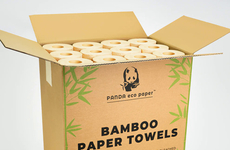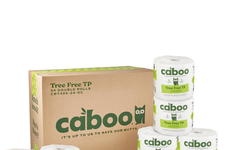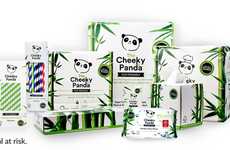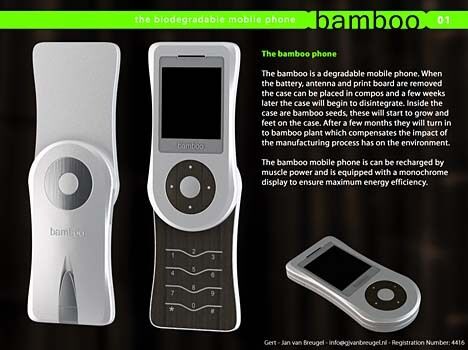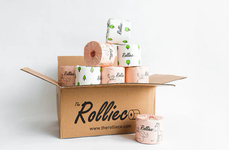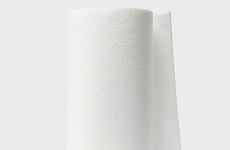
Top 8 Bamboo Innovations
References: nowtoronto
After featuring several bamboo products, hailing them as eco-friendly alternatives for flooring, furniture, salad bowls, dresses, and even underwear, I wanted to know what bamboo offers that allows it to fall under the category of 'green' trends.
Why is chopping bamboo any less damaging than cutting down trees?
Well, the short answer is that bamboo grows a lot quicker. Trees take hundreds of years to grow into optimal harvesting size, but bamboo, which is actually classified as a grass, can reach tremendous heights in the course of a single year. In a one month period, bamboo has been known to grow an entire foot, and that without the help of chemical pesticides and fertilizers.
Bamboo has benefits in it living state too (besides feeding Pandas of course.) The root system works to prevent erosion on steep surfaces, and the plant itself is strong enough to resist intense weather conditions like typhoons. Bamboo has also been recognized for its ability to detoxify water by absorbing heavy metals.
"Bamboo is, like, the hottest eco fibre since hemp Ts swept the granola movement decades ago," NOW Magazine explains. "The speedy weed is being incarnated into slick bamboo decor, flooring, towels hell, even bamboo bras faster than you can spell 'panda.' But there are some cracks in its green facade."
Unfortunately, like many natural resources, even the existence of bamboo is being threatened, with one third of the world's species nearing extinction.
"Many survive only in wee patches of forest, and their loss is threatening rare animals like giant pandas, Madagascar's golden lemurs and Africa's mountain gorillas," NOW said.
Most products aren't made of the bamboo loved by pandas; not only is it too thin, but China has begun regulating it. The world has over 1,200 bamboo species though, and a lot of them are endangered due agriculture, fuel and the timber industry.
That's why it's important to do your research and find companies who value the ethical components of bamboo. Coastal Architectural Materials, for example, not only uses bamboo from sustainable forests, but keeps their flooring and other products eco-friendly from start to finish.
"Once cut, our bamboo strips are treated in an organic solution, and little energy and almost no water is used in the manufacture of our plywood and floors," Kirk Van Ludwig said of the company. "Our bamboo products are available in very low voc to formaldehyde free."
The same caution applies to bamboo clothing, so make sure it is in fact sustainable by doing your research.
It's really irrelevant where the bamboo is from, what matters is that it's eco-friendly and no forests were destroyed in the process. Buying bamboo to be green is pointless if you find out the product you've purchased isn't the sustainable kind.
Why is chopping bamboo any less damaging than cutting down trees?
Well, the short answer is that bamboo grows a lot quicker. Trees take hundreds of years to grow into optimal harvesting size, but bamboo, which is actually classified as a grass, can reach tremendous heights in the course of a single year. In a one month period, bamboo has been known to grow an entire foot, and that without the help of chemical pesticides and fertilizers.
Bamboo has benefits in it living state too (besides feeding Pandas of course.) The root system works to prevent erosion on steep surfaces, and the plant itself is strong enough to resist intense weather conditions like typhoons. Bamboo has also been recognized for its ability to detoxify water by absorbing heavy metals.
"Bamboo is, like, the hottest eco fibre since hemp Ts swept the granola movement decades ago," NOW Magazine explains. "The speedy weed is being incarnated into slick bamboo decor, flooring, towels hell, even bamboo bras faster than you can spell 'panda.' But there are some cracks in its green facade."
Unfortunately, like many natural resources, even the existence of bamboo is being threatened, with one third of the world's species nearing extinction.
"Many survive only in wee patches of forest, and their loss is threatening rare animals like giant pandas, Madagascar's golden lemurs and Africa's mountain gorillas," NOW said.
Most products aren't made of the bamboo loved by pandas; not only is it too thin, but China has begun regulating it. The world has over 1,200 bamboo species though, and a lot of them are endangered due agriculture, fuel and the timber industry.
That's why it's important to do your research and find companies who value the ethical components of bamboo. Coastal Architectural Materials, for example, not only uses bamboo from sustainable forests, but keeps their flooring and other products eco-friendly from start to finish.
"Once cut, our bamboo strips are treated in an organic solution, and little energy and almost no water is used in the manufacture of our plywood and floors," Kirk Van Ludwig said of the company. "Our bamboo products are available in very low voc to formaldehyde free."
The same caution applies to bamboo clothing, so make sure it is in fact sustainable by doing your research.
It's really irrelevant where the bamboo is from, what matters is that it's eco-friendly and no forests were destroyed in the process. Buying bamboo to be green is pointless if you find out the product you've purchased isn't the sustainable kind.
Trend Themes
1. Sustainable Bamboo Products - Disruptive innovation opportunities include developing new eco-friendly bamboo products for various industries such as flooring, furniture, and clothing.
2. Bamboo Conservation - Disruptive innovation opportunities include implementing sustainable practices to protect and preserve bamboo forests and prevent the extinction of bamboo species.
3. Bamboo Manufacturing Processes - Disruptive innovation opportunities include finding new and efficient ways to manufacture bamboo products with minimal energy and water usage.
Industry Implications
1. Interior Design - Disruptive innovation opportunities include incorporating sustainable bamboo materials into interior design projects.
2. Fashion - Disruptive innovation opportunities include creating eco-friendly and stylish clothing using sustainable bamboo fibers.
3. Environmental Conservation - Disruptive innovation opportunities include developing strategies and technologies to protect and restore bamboo forests and their ecosystems.
5.7
Score
Popularity
Activity
Freshness

